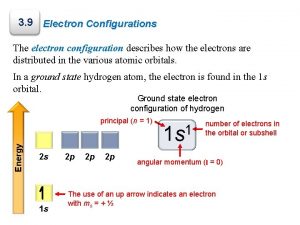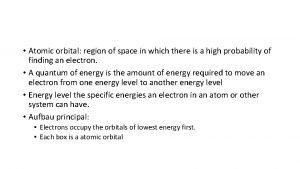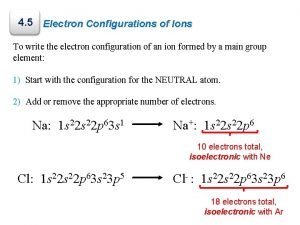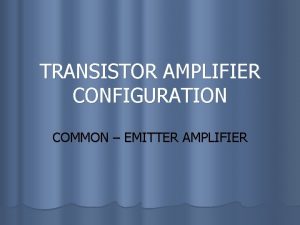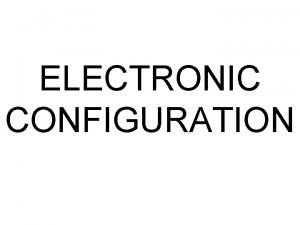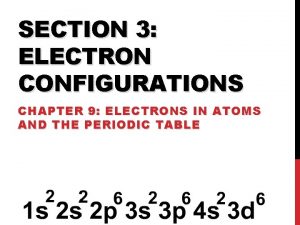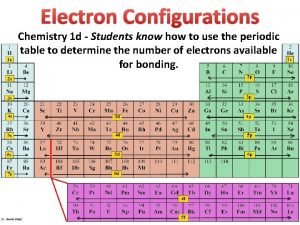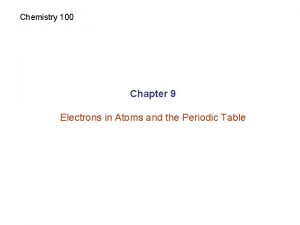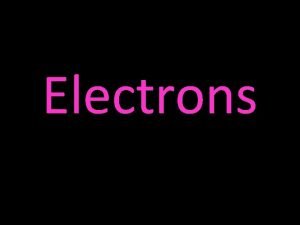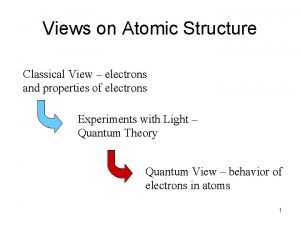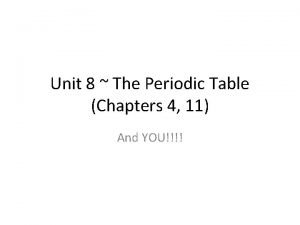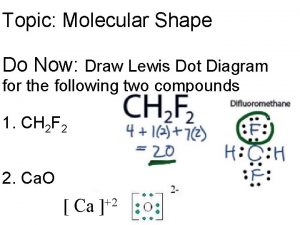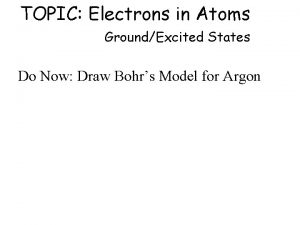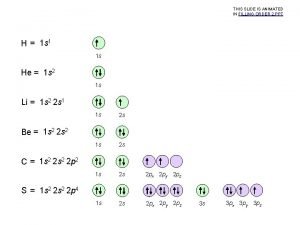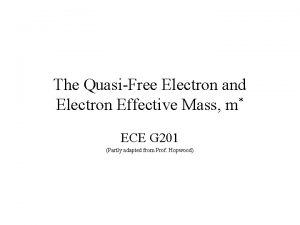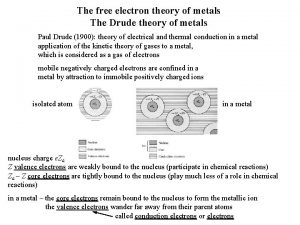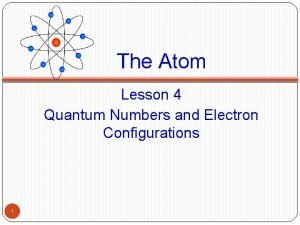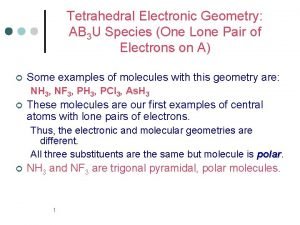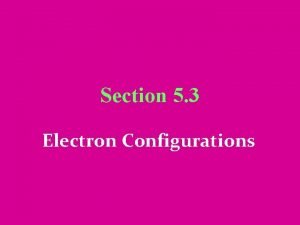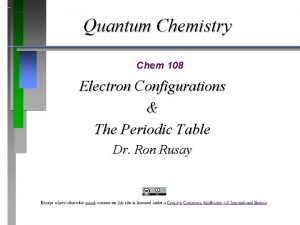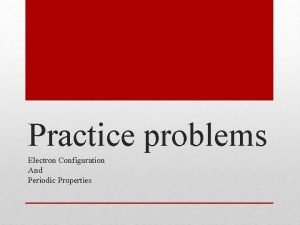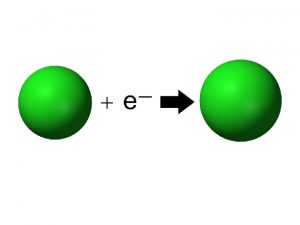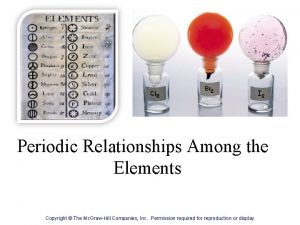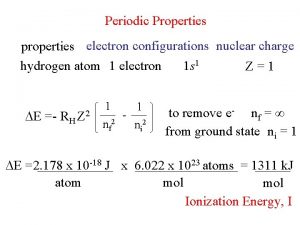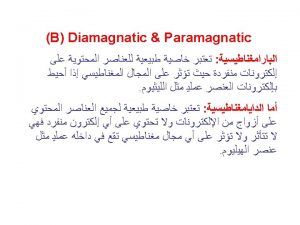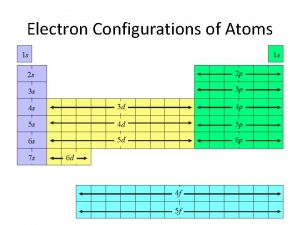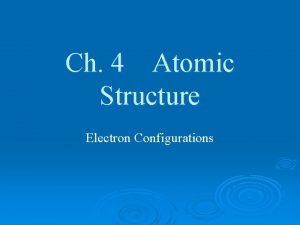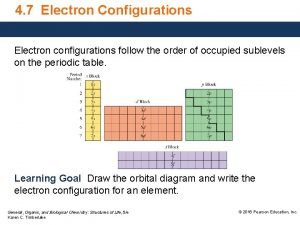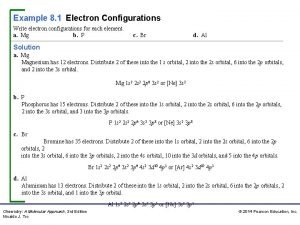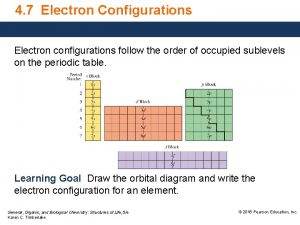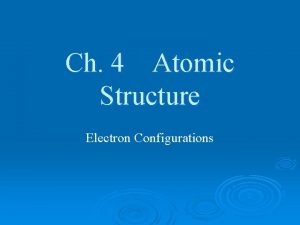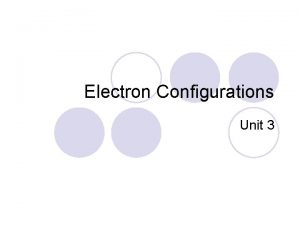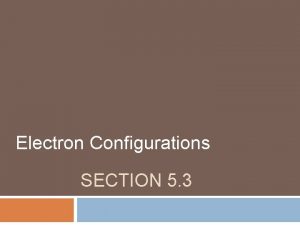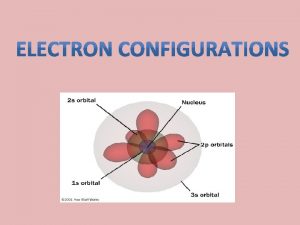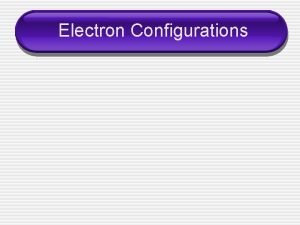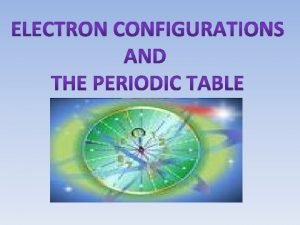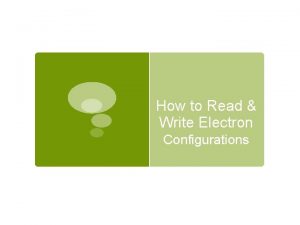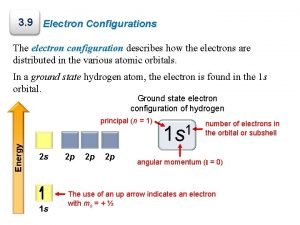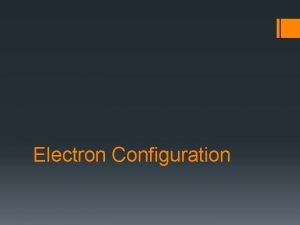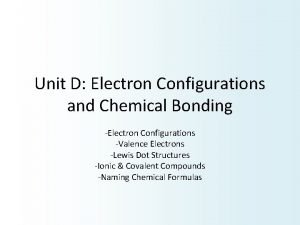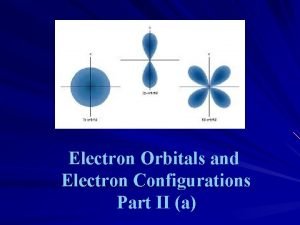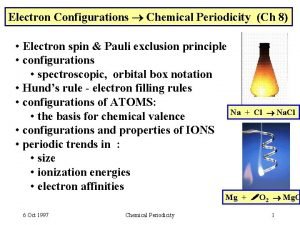Electron Configurations Chemistry 1 d Students know how















































- Slides: 47

Electron Configurations Chemistry 1 d - Students know how to use the periodic table to determine the number of electrons available for bonding.

How to identify an element: - Look at the protons How to find protons: - Look at the atomic number How to find neutrons: - Subtract atomic mass from atomic number (the # of protons) How to find electrons in a neutral (no charge) atom : - Always equals the number of protons

The Periodic Table and Electrons • Atomic number tells us how many electrons an atom has in a neutral atom • Valence electrons (the outermost e-) are known by looking at the elements’ family/group But how do we know where all an element’s electrons are found?

Electron Configurations • Arrangement of the periodic table which tells us where each electron in an atom is located (which energy level and sublevel) and explains how electrons fill an atom - Which Orbital do I go to? Negative electron Nucleus

Energy Levels • Rows/Periods = Energy Levels (7 on PT) • Energy levels are divided into sublevels (s, p, d, f) • Sublevels are divided into a shape of space called orbitals • Each orbital/shape can ONLY hold 2 electrons!

s, p, d, f Blocks • The periodic table can be divided into sections called blocks (energy sublevels) • 4 blocks/sublevels = s, p, d, f • s, p, d, f sublevels are divided into orbitals • s = 1 shape • p = 3 shapes • d = 5 shapes • f = 7 shapes


Remember…S, P, D, & F blocks refer to the shape of the orbital in which electrons are found!

p-BLOCK s-BLOCK Helium is moved over by Hydrogen d-BLOCK f. BLOCK

s-BLOCK d-BLOCK p-BLOCK many Just. How Count the # of Elements in each electrons can fit Block! in each Orbital? f. BLOCK

s-BLOCK 2 ELECTRONS d-BLOCK 10 Electrons f. BLOCK 14 Electrons p-BLOCK 6 Electrons

How many electrons are in each block? • • s-block = 2 electrons p-block = 6 electrons d-block = 10 electrons f-block = 14 electrons Just count the # of elements in each block!

How many electrons per energy level (row)? 1. N = 1 (1 st row/energy level): • Smallest energy level • Can only hold 2 electrons (2 = s-block) 2. N = 2 (2 nd row/energy level): • A little larger than the first • Can only hold 8 electrons (2 = s-block; 6 = pblock)

3. N = 3 (3 rd row/energy level): • A little larger than the second • Can hold 18 electrons (2 = s-Block; 6 = p-Block; 10 = d-Block) 4. N = 4 (4 th row/energy level): • Larger than the third energy level • Can hold 32 electrons 5. N = 5 (5 th row/energy level): • Larger than the fourth energy level • Can hold 50 electrons

6. N = 6 (6 th row/energy level): • Larger than the 5 th energy level • Can hold 72 electrons 7. N = 7 (7 th row/energy level): • Largest energy level • Can hold 98 electrons 2 2 n 2 2(6) 2(36) = 72 The rule for determining the number of electrons is 2(n 2) The number of energy levels in represented in N.

s 1 S 2 S 3 S 4 S 5 S 6 S 7 S The S-Block always fills first! d 3 D D-Block ONE 4 D Behind! 5 D 6 D f 4 F 5 F p 2 P 3 P 4 P Row 5 P 6 P 7 P F-Block TWO Rows Behind!

How Electrons Fill Orbitals (The Order of fill) 1 s 2 s 3 s 4 s 5 s 6 s 7 s 4 f 5 f 3 d 4 d 5 d 6 d 2 p 3 p 4 p 5 p 6 p 7 p


s p 1 2 d 3 4 5 6 7 f

Steps for Finding Electron Configurations for an Element 1. Find the element. 2. List the energy levels, orbitals (blocks), and number of electrons in each block as you make your way to the element that you are trying to find the configuration for. Cerium 1 s 2 2 s 2 p 6 3 s 2 p 6 d 10 4 s 2 p 6 d 10 f 1 5 s 2 p 6 d 1 6 s 2

He s 1 2 3 4 5 2 1 s p What is the Atomic Number of Helium? d 6 7 f

Cl s 1 2 1 s 22 p 63 s 23 p 5 d 3 4 5 6 7 f p

2 2 6 2 5 1 s 2 s 2 p 3 s 3 p Energy Levels

2 2 6 2 5 1 s 2 s 2 p 3 s 3 p Orbitals

2 2 6 2 5 1 s 2 s 2 p 3 s 3 p Check work by counting number of electrons! Electrons

z y For this presentation, the nucleus of the atom is at the center of the three axes. x

The “ 1 s” orbital is a sphere, centered around the nucleus



The 2 s orbital is also a sphere.

The 2 s electrons have a higher energy than the 1 s electrons. Therefore, the 2 s electrons are generally more distant from the nucleus, making the 2 s orbital larger than the 1 s orbital.

1 s orbital

2 s orbital

z 2 px y x

z 2 px and 2 pz y x

z The three 2 p orbitals, 2 px, 2 py, 2 pz y x

once the 1 s orbital is filled,

the 2 s orbital begins to fill

once the 2 s orbital is filled,

the 2 p orbitals begin to fill

each 2 p orbital intersects the 2 s orbital and the 1 s orbital

each 2 p orbital gets one electron before pairing begins

once each 2 p orbital is filled with a pair of electrons, then

the 3 s orbital gets the next two electrons

the 3 s electrons have a higher energy than 1 s, 2 s, or 2 p electrons,

so 3 s electrons are generally found further from the nucleus than 1 s, 2 s, or 2 p electrons

 Electron configuration special cases
Electron configuration special cases C n o f electron affinity
C n o f electron affinity Stable electron configurations are likely to contain
Stable electron configurations are likely to contain Ccechs
Ccechs Stable electron configurations are likely to contain
Stable electron configurations are likely to contain Ionic 5 electron
Ionic 5 electron Stable electron configurations
Stable electron configurations Base subbase subgrade
Base subbase subgrade Icq transistor
Icq transistor Electronic configuration of all
Electronic configuration of all Electrons in atoms section 3 electron configuration
Electrons in atoms section 3 electron configuration Electrons configurations
Electrons configurations Electrons configurations
Electrons configurations Uses of bjt
Uses of bjt Ceedar innovation configurations
Ceedar innovation configurations Know history know self
Know history know self Dilan gorur
Dilan gorur I'm holding on to your promises you are faithful
I'm holding on to your promises you are faithful Rizal and his party went to pagsanjan for what reason?
Rizal and his party went to pagsanjan for what reason? Chemistry electron
Chemistry electron Elctron configuration
Elctron configuration Ib organic chemistry
Ib organic chemistry Organic vs inorganic chemistry
Organic vs inorganic chemistry Octahedral bond angle
Octahedral bond angle Heisenberg uncertainty principle
Heisenberg uncertainty principle Exothermic electron affinity trend
Exothermic electron affinity trend Whats the trend for atomic radius
Whats the trend for atomic radius Lewis dot structure
Lewis dot structure Excited state electron configuration
Excited state electron configuration Electron transfer in redox reaction
Electron transfer in redox reaction Orbital diagram for nickel
Orbital diagram for nickel Quasi free electron
Quasi free electron Difference between light microscope and electron microscope
Difference between light microscope and electron microscope Drude theory of metals
Drude theory of metals Quantum numbers and electron configuration
Quantum numbers and electron configuration Tetrahedral electron geometry
Tetrahedral electron geometry Animal cell structure under electron microscope
Animal cell structure under electron microscope Electron cloud shape
Electron cloud shape Electron filling order
Electron filling order Surrounds the nucleus
Surrounds the nucleus Oganesson electron configuration
Oganesson electron configuration 6 the periodic table practice problems
6 the periodic table practice problems Cyclic electron flow
Cyclic electron flow Electron affinity trend
Electron affinity trend Periodic table of elements 1s 2s
Periodic table of elements 1s 2s Periodic relationships
Periodic relationships Li ground state electron configuration
Li ground state electron configuration Paramagnetic unpaired electrons
Paramagnetic unpaired electrons
